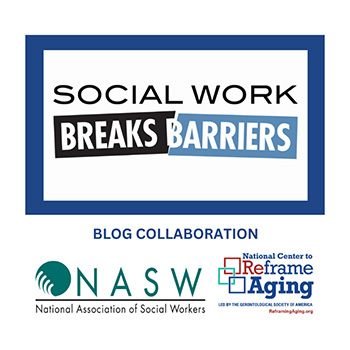
Enhancing Your Communication About Aging
During Social Work Month and Beyond
By Hannah Albers, BA; Alycia Claproth, MSW; Chris Herman, MSW, LICSW

March is Social Work Month, and the 2023 theme is "Social Work Breaks Barriers." More than 700,000 social workers nationwide entered the profession because they have a commitment to making our communities, our country, and our world a better place for all. During Social Work Month, NASW is spearheading efforts to increase public awareness about how social workers continue to break barriers in all communities, and how the contributions of this essential profession improve our nation.
The National Center to Reframe Aging is dedicated to ending ageism by advancing an equitable and complete story about aging in America. The center is the trusted source for proven communication strategies and tools to effectively frame aging issues. It is the nation’s leading organization cultivating an active community of individuals and organizations to spread awareness of implicit bias against older people and influence policies and programs that benefit us all of us as we age.
In recognition of Social Work Month, NASW and the National Center have collaborated to bring you these tips on how social workers can integrate effective framing about aging in our work:
Assessment
When engaging with our clients in a collaborative assessment process, we can combine our person-centered approach with age-inclusive language that reinforces the client’s sense of agency. We can also emphasize interdependence as a reality at every age.
Example: Focus on the client’s strengths and goals to highlight how social work services and other resources can help realize those goals. Explain that all of us rely on supports and services throughout our lives to normalize the need for additional support, reinforce the client’s self-determination to the extent possible within the continuum of physical and cognitive capability.
Advocacy and Other Outreach
Policies and programs that promote health and well-being in later life benefit people of all ages. In our communications with colleagues (both within and beyond our respective organizations), policymakers, funders, and other stakeholders, we can highlight our collective responsibility as a society to reduce barriers to age-inclusive physical and social environments and to strengthen resources that support us all as we age.
Example: “One of our society’s strengths is our belief in justice. A just society ensures that everyone, regardless of age, can participate and contribute in meaningful ways. Too often, we limit opportunities for older people and minimize their contributions. This is unjust to older people and a loss to our communities. To live up to our ideals, we must confront the injustice of ageism.”
For more information, visit our Aging practice page and the National Center to Reframe Aging.
About the Authors
Hannah Albers, BA (she, her), is program director of the National Center to Reframe Aging, led by the Gerontological Society of America on behalf of ten leading aging organizations. She is trained as a facilitator of effective framing strategies.
Alycia Claproth, MSW (she, her), is the communications manager at the National Center to Reframe Aging. She comes to the National Center with a background in Reframing Elder Abuse.
Chris Herman, MSW, LICSW (she, her), is senior practice associate–aging in the NASW national office. She has been trained in the Reframing Aging communications strategy and leads NASW’s dissemination and integration of the Reframing Elder Abuse Initiative, a sister project led by the National Center on Elder Abuse.